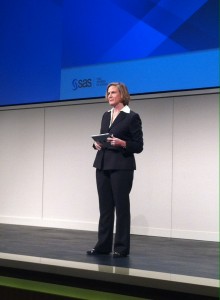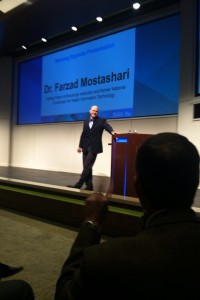The health and life sciences industries affect all other industries on two levels – our employers and governments are heavily involved as influencers in payment systems, and as individuals we all engage directly with health care organizations. Because of those two reasons, people in all industries have a stake in how the healthcare ecosystem evolves in the face of change.
Big changes

And talk about change! Kecia Serwin, Vice President and General Manager, SAS Health and Life Sciences sums it up this way. The three greatest drivers of change in the healthcare ecosystem right now are:
- Technology and innovation
- Government mandates
- Empowered consumers
And each of those three change drivers have such a compelling mix of challenges and opportunities that how organizations respond to them will determine who will matter in the future – and who will not. So Kecia asks, what can really move the needle? What’s working? How can we transform our organizations the way we need to?
It’s no longer about payers – providers – pharma; it’s now about the whole health care ecosystem. New models involve greater collaboration and shared risks/rewards. And perhaps most signigicantly, new strategies are emerging to deal with the new empowered consumer.
How Health Analytics moves the needle
What does Health Analytics really mean? The broadest definition is that it’s the collection of enabling technologies and skills that can be used to generate insight to support strategic decision-making. Health Analytics makes extensive use of data – data collection for meaningful use, data sharing for collaboration and health information exchanges, and data analyses to inform and to allow predictions.
Traditionally, analyses have been retrospective, so the focus was primarily on explaining and describing. As in the case of caring for an individual health condition – the diagnosis is fundamental. But what really matters is the treatment plan that drives the best outcome. So to move the needle, it comes from the power of forward-looking predictive analytics. It’s the ability to conduct accurate what-if simulations and include qualitative data that enables the consideration of what could and should happen, and most importantly – knowing the best thing that can happen.
Health Analytics is key to the treatment plan

So of those three drivers of change that Kecia identifies, is there a common thread? Dr. Farzad Mostashari, visiting fellow at the Brookings Institution says that the biggest underlying reason is that health care “costs too damn much and we’re not getting enough value for it.” And he sees all the changes holistically coming in the shift from “volume” to “value” of care, were quality will be measured and rewarded, as will be total cost. And both safety and appropriateness will matter.
As the health care ecosystem evolves, health plans will be sharing risk with providers on the total cost of care. In the United States, we’ve seen a similar shift with the advent of managed care – which heralded a new era of cost-containment that never quite materialized. Dr. Mostashari believes that’s what’s different now is that we now have the ability to predict. Based on data, we can predict hospitalizations, Emergency Room visits and other events.
Envisioning individual patient benefits is a powerful way to understand the impact of health analytics’ ability to produce accurate predictions. Just imagine:
- Reaching quicker and more accurate diagnoses – knowing sooner what’s wrong and getting better earlier.
- Using data-driven treatment plans of drugs, therapies and behavior modification tailored to patient preferences and demonstrated past efficacies.
- Getting adherence to prescription regimens based on relevant rewards.
If each scenario results in fewer sick days, or reduced traffic accidents, and/or overall higher quality of life, then imagine the economic impact at a population level. To be sure, what’s different now is our ability to predict, but what’s also different is that we now have empowered consumers.
Caring for the patient as a consumer
Patients show up in waiting rooms and hospitals with specific conditions that need attention. The organizations engaged in the care of the health of that patient have traditionally focused on the condition at hand. Frequently, how they receive care is determined by the condition and the payment parameters set by the applicable health insurance plan. But the patient shows up as a whole person with needs, desires and expectations from living in a technology-driven online-all-the-time social savvy world.
And with the shift in the overall market toward more individual participation in health insurance coverage from the affordable health care act, the patient will become choosier – and will have the ability (and desire) to make choices more easily.
As electronic medical records have become more prevalent, so has the ability to use data to care for patients as consumers. And all these changes will translate into care improvements and the potential cost savings we all have a stake in achieving. Dr. Mostashari lays out a few ways to pursue that path:
- Find ways to get feedback loops to pursue continuous improvement. In doing that, look for ways to collect data in ways that are accurate but not individually-identifiable.
- Embrace testing and experimentation. Science and medicine invented the randomized trial, for goodness’ sake, so this should be a natural.
- Prepare for operating based on improved outcomes. Currently, the economics of health care are oriented toward numbers of patients and numbers of procedures. That is quickly changing.
- Engage the patient and his/her family as key players in the care of the individual. Most treatment regimens and outcomes happen at home and not in the clinical environment, and other factors matter, such as nutrition, hygiene and mobility.
- Make the easy thing to do the right thing to do. As Dr. Mostashari puts it, “there’s too much friction in the health care ecosystem.”
By friction, he means all the different obstacles that patients face in getting care – from bad waiting rooms, unnecessarily complex claims payment & processing, to having to deal with outsourced procedures that the physician needs to complete the diagnosis or the treatment.
As a non-medical “lay person,” what I am hearing from all that is the need to become more customer-centric. Along with that, of course, the role of customer analytics and health analytics is to enable the decision-making process so all players can make decisions on an informed basis, and to center their thinking – and operating – around the idea that it’s all about the patient/consumer. That’s like music to this marketer’s ears!
One additional piece of advice from Dr. Mostashari applies to any industry:
Don’t ever surprise your Board or your Customers.
And so the good Doctor has spoken.
------------
Kecia Serwin and Dr. Farzad Mostashari presented the Welcome Address and Keynote Presentation at the 11th Annual SAS Health Analytics Executive Conference in Cary, NC on May 14, 2014.

1 Comment
Pingback: How analytics informs in the new health care ecosystem